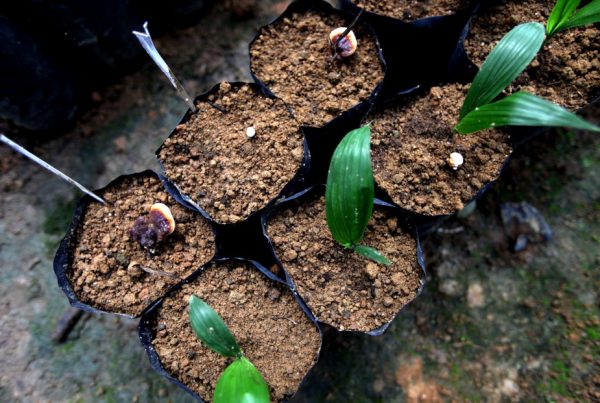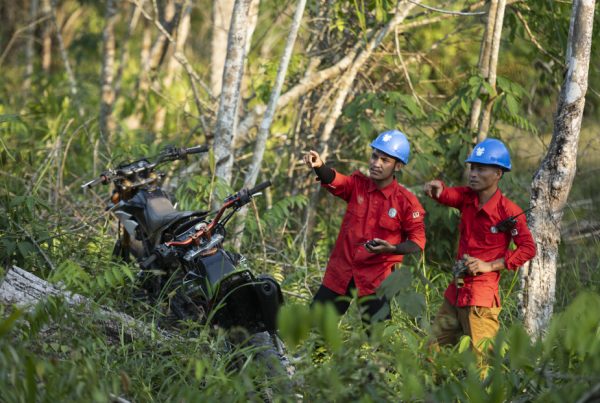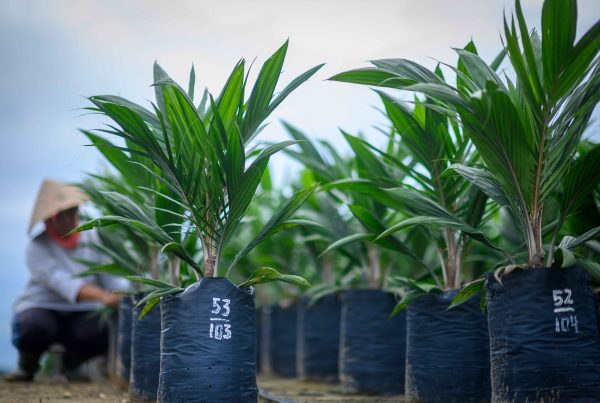Asian Agri launched its Fire-Free Village Program (FFVP) in 2016 to help prevent forest and land fires in Indonesia.
The FFVP program focuses on working with local communities to raise awareness of the dangers of fire, and provide them with alternatives to traditional slash-and-burn methods of clearing land, as well as economic incentives to prevent burning on their land.
The program began with nine villages in Riau and Jambi. Now, the program reaches 16 villages across the two provinces, covering more than 343,000 hectares, as reported in our 2024 Sustainability Report.
This article will examine:
- The background and goals of the Fire-Free Village Program
- How the program helps prevent fires through training, tools, and local partnerships
- The results communities have seen from joining the program
Understanding the Fire-Free Village Program
Forest and land fires in Indonesia often begin at the village level, when land is cleared using fire, a traditional method for clearing land quickly and cheaply. On dry peat soils, especially during El Niño, these sparks can quickly grow into uncontrollable blazes.
To address this risk, the Fire-Free Village Program focuses on prevention at the community level. At its core, the FFVP is guided by five principles:
- Enhancement – raising awareness about the dangers of fire and haze.
- Empowerment – training local fire crew leaders in prevention and early response techniques.
- Development – supporting projects that improve livelihoods and reduce reliance on fire-based farming.
- Assistance – providing sustainable, non-burning alternatives for land clearing.
- Reward – offering incentives to villages that remain fire-free.
How FFVP Works: Training, Tools, and Local Partnerships
The first step in FFVP’s approach is mapping. By studying past fire records and spotting potential danger zones, the program identifies which areas around each village are most at risk. This process ties back to the enhancement principle, giving communities a clearer picture of the threats they face.
Asian Agri’s fire team works with the Ministry of Forestry and Manggala Agni, the national forest fire task force, to monitor the land. They also carry out regular patrols with the support of local officials and community members.
“We never draw those risk maps alone,” says Dani Nugraha Syafly, Fire Assistant at Asian Agri. “We walk the borders with the villagers, point out the dry spots together, and let them see how quickly a small spark could spread. That shared view turns the idea of forest fire prevention into a commitment everyone is ready to sign.”
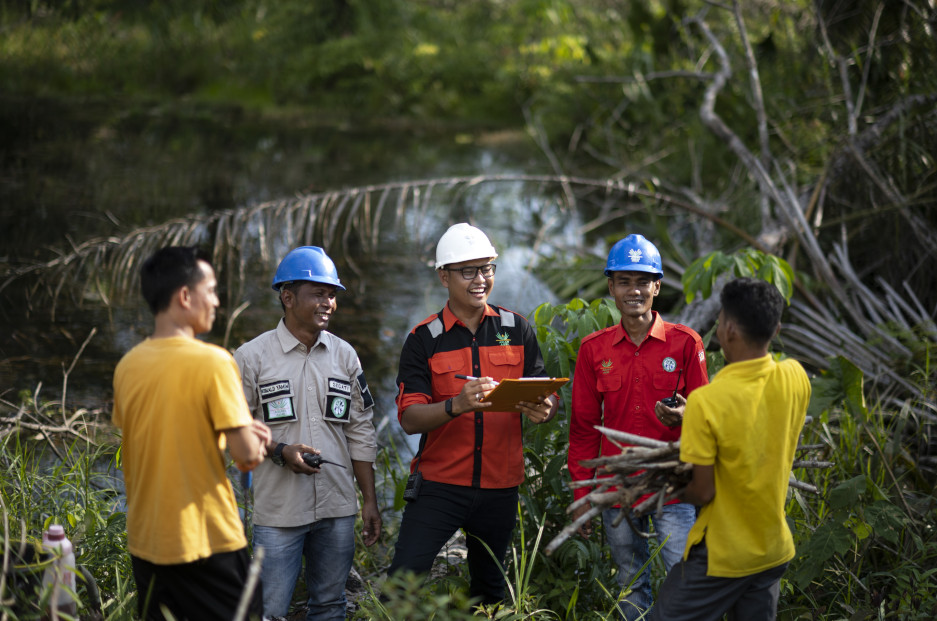
Asian Agri’s fire prevention team meet regularly with village representatives to prevent fire on community land.
Once the fire-prone areas are mapped, Asian Agri meets with village leaders to discuss how they can work together, including what support the company will provide and what responsibilities the community will take on to prevent fires. If the village agrees, both sides sign a formal agreement to mark the official start of the program.
From there, Asian Agri begins providing practical help, supporting the partner village with basic fire prevention equipment, such as:
- Water pumps for firefighting response
- Hoses and spray units to control outbreaks quickly
- Communication tools for alerting teams and coordinating patrols
These tools help local teams act quickly when fire threats appear. But tools alone are not enough – community engagement and awareness are essential.
The heart of the program is its people. Villagers are not just participants – they are trained to take the lead in preventing fires before they start. Those who are physically fit, understand fire safety, and can inspire others are chosen as crew leaders, reflecting the empowerment principle in action.
Their role is to:
- Organize and lead patrols
- Coordinate with local authorities
- Educate neighbors on fire prevention methods
Each crew leader completes 52 hours of theory and three days of fieldwork. The training includes:
- GPS (Global Positioning System) operation
- Fire patrol routines
- Community outreach
- Controlled fire drills
FFVP’s development principle looks at the village as a whole. The team sits with village leaders and assesses what the village is good at, such as crops, skills, or natural resources.
They then help turn those into real opportunities, like improving infrastructure, supporting local businesses, or strengthening village groups. The goal is to make the whole village more resilient.
The program also encourages villagers to reduce activities that put pressure on nearby forests. One way we do this is by introducing alternative sources of income, such as producing and selling honey, pineapples, and durians. We provide training and guidance to help them develop these livelihoods, allowing them to earn a stable income while protecting the surrounding environment.
FFVP also helps communities find safer and more sustainable ways to manage their land. Instead of using slash-and-burn techniques for clearing, we loan villagers the necessary machinery so they can prepare their land without burning.
Benefits of Community Fire Prevention
For many villages, the Fire-Free Village Program brings benefits that go beyond fire prevention. Communities that succeed in keeping their land safe also receive in-kind support and resources to strengthen their preparedness. This is where the reward principle comes into play.
Villages that reduce the burned are on their land to under one hectare receive a partial reward of IDR 50 million, while those that successfully prevent any fires for a full year can earn up to IDR 100 million.
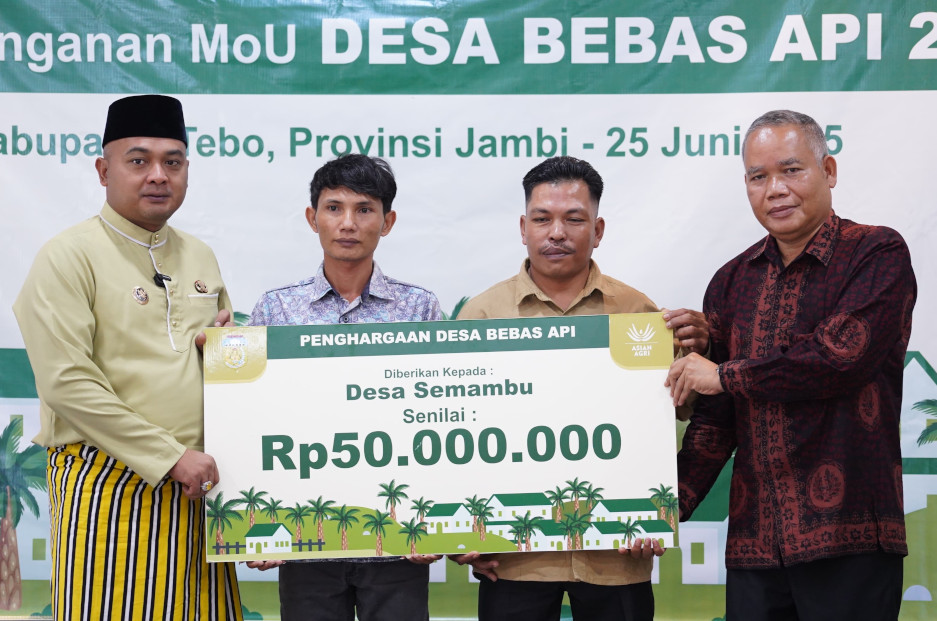
Desa Semambu receiving an incentive of IDR 50 million at the FFVP Awards in Jambi on June 2025
This incentive structure is what makes FFVP unique. Instead of direct cash payouts, the rewards are channeled into community development projects that benefit the entire community.
Most importantly, local communities are taking real ownership of keeping their land fire-free, and there’s a sense of pride in it.
Awareness about fire risks has grown, and that knowledge is being passed from neighbor to neighbor. Village crew leaders, who used to be seen as just volunteers, are now trusted guides the community turns to for advice on preventing fires.
“As a crew leader, I’ve seen real change. People are more aware, more disciplined, and more willing to work together to prevent fires,” says Edi Susanto, crew leader from Desa Semambu.
Such a shift in mindset is one of the clearest signs that the program is working.
It’s not only about avoiding fires but also about building a culture that values prevention, cooperation, and long-term planning. This attitude becomes especially important during El Niño periods, when conditions are drier.
The training, tools, and teamwork developed through FFVP help communities stay alert and act swiftly – before small sparks turn into large disasters.
Looking ahead, there’s always room for optimism. To keep the momentum going and ensure lasting impact, Asian Agri and participating villages renew their Fire-Free Village Program agreement each year through a Memorandum of Understanding.
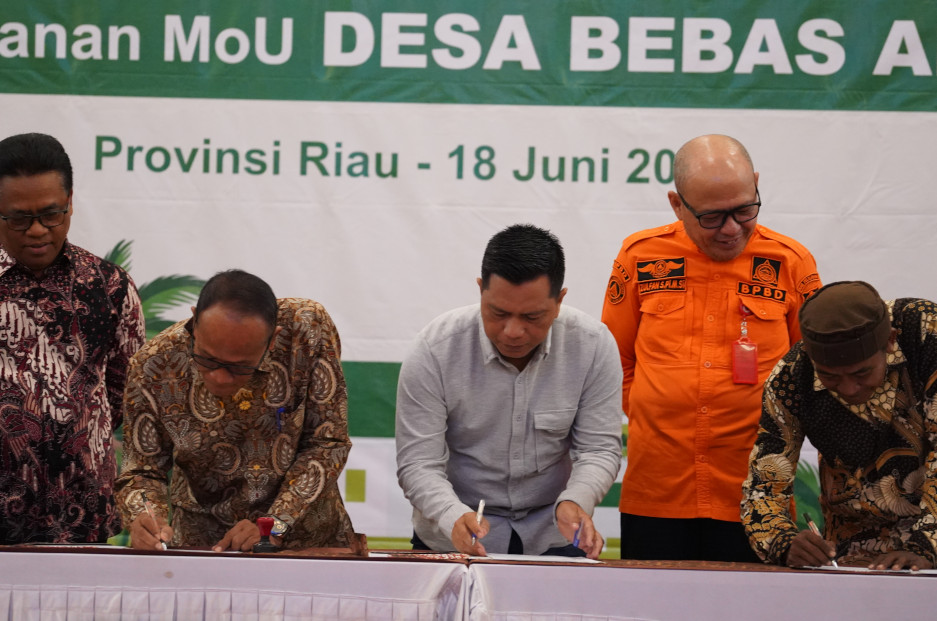
Villages under FFVP program renewing their commitment at FFVP Awards in Pekanbaru, Riau, on June 2025
The agreement brings fresh momentum. It includes advanced training for village fire teams, improved tools for early detection and response, a community-based reporting system, and performance-based rewards for villages that stay fire-free.
The aim is to make the collaboration more structured and long lasting while helping communities grow stronger and more resilient in the face of climate challenges.
With continued commitment, shared responsibility, and on-the-ground support, communities are demonstrating that fire prevention doesn’t have to be a struggle. It can be a shared success story – one that grows stronger every year.
Frequently Asked Questions (FAQ)
1. What is the Fire-Free Village Program (FFVP)?
The Fire-Free Village Program (FFVP) is Asian Agri’s community-based fire prevention initiative designed to stop land and forest fires before they start. Through training, fire prevention equipment, awareness campaigns, and performance-based incentives, the program empowers local residents to monitor risks, detect hotspots early, and respond quickly during dry seasons, including El Niño years.
2. How does the program support forest fire prevention on a daily basis?
Asian Agri’s Fire Free Village Program helps communities prevent fires through daily patrols, mapping high-risk areas, and using safe land management methods like controlled clearing and firebreaks. Villagers receive training, tools such as water pumps, hoses, and radios, and guidance on alternative land-clearing methods. The program also promotes sustainable livelihoods and economic incentives, reducing the need for slash-and-burn agriculture and strengthening community resilience.
3. Why is community involvement so important?
Community involvement in Asian Agri’s Fire Free Village Program is crucial because fires in Indonesia often start on or near village land. Villagers act as the first line of defense, detecting smoke early, sharing alerts, and responding quickly. Engagement also raises awareness of fire risks, encourages safe land management, and supports alternative livelihoods that reduce reliance on burning. By taking ownership of fire prevention, communities build a culture of cooperation, long-term planning, and resilience.
4. How are villages rewarded for staying fire-free?
Asian Agri’s Fire Free Village Program rewards communities for preventing fires on their land. Villages that limit fire damage to under one hectare receive IDR 50 million in community development funds, while villages with zero fires earn IDR 100 million. These rewards are used for projects like improving schools, roads, and health posts, turning fire prevention into a tangible community benefit and encouraging long-term participation.
5. What training do crew leaders receive?
Each leader completes 52 hours of theory plus three days of field drills covering GPS navigation, patrol routines, and safe-use of fire prevention and protection tools. This intensive training ensures every team can act confidently during an emergency.
Learn how fire prevention fits into Asian Agri’s broader sustainability efforts


